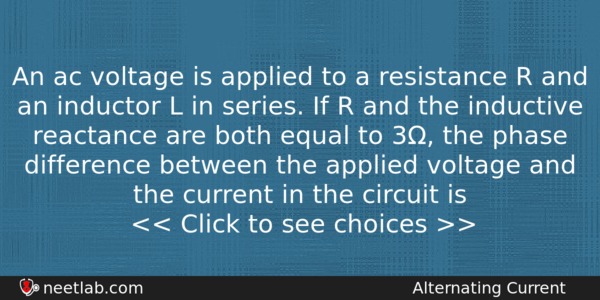| ⇦ | 
| ⇨ |
An ac voltage is applied to a resistance R and an inductor L in series. If R and the inductive reactance are both equal to 3Ω, the phase difference between the applied voltage and the current in the circuit is
Options
(a) π/6
(b) π/4
(c) π/2
(d) zero
Correct Answer:
π/4
Explanation:
The phase difference is given by
tan ? = Xₗ / R = 3/3 = 1
? = π/4
Related Questions: - A ballet dancer, dancing on smooth floor, is spinning about a vertical axis
- What is the nature of Gaussian surface involved in Gauss’s law of electrostatics?
- Two parallel beams of positron moving in the same direction will
- If an electron and a positron annihilate, the energy released is
- A spherical shell of radius 10cm is carrying a charge q. If the electric potential
Topics: Alternating Current
(96)
Subject: Physics
(2479)
Important MCQs Based on Medical Entrance Examinations To Improve Your NEET Score
- A ballet dancer, dancing on smooth floor, is spinning about a vertical axis
- What is the nature of Gaussian surface involved in Gauss’s law of electrostatics?
- Two parallel beams of positron moving in the same direction will
- If an electron and a positron annihilate, the energy released is
- A spherical shell of radius 10cm is carrying a charge q. If the electric potential
Topics: Alternating Current (96)
Subject: Physics (2479)
Important MCQs Based on Medical Entrance Examinations To Improve Your NEET Score
18000+ students are using NEETLab to improve their score. What about you?
Solve Previous Year MCQs, Mock Tests, Topicwise Practice Tests, Identify Weak Topics, Formula Flash cards and much more is available in NEETLab Android App to improve your NEET score.
Share this page with your friends

Leave a Reply